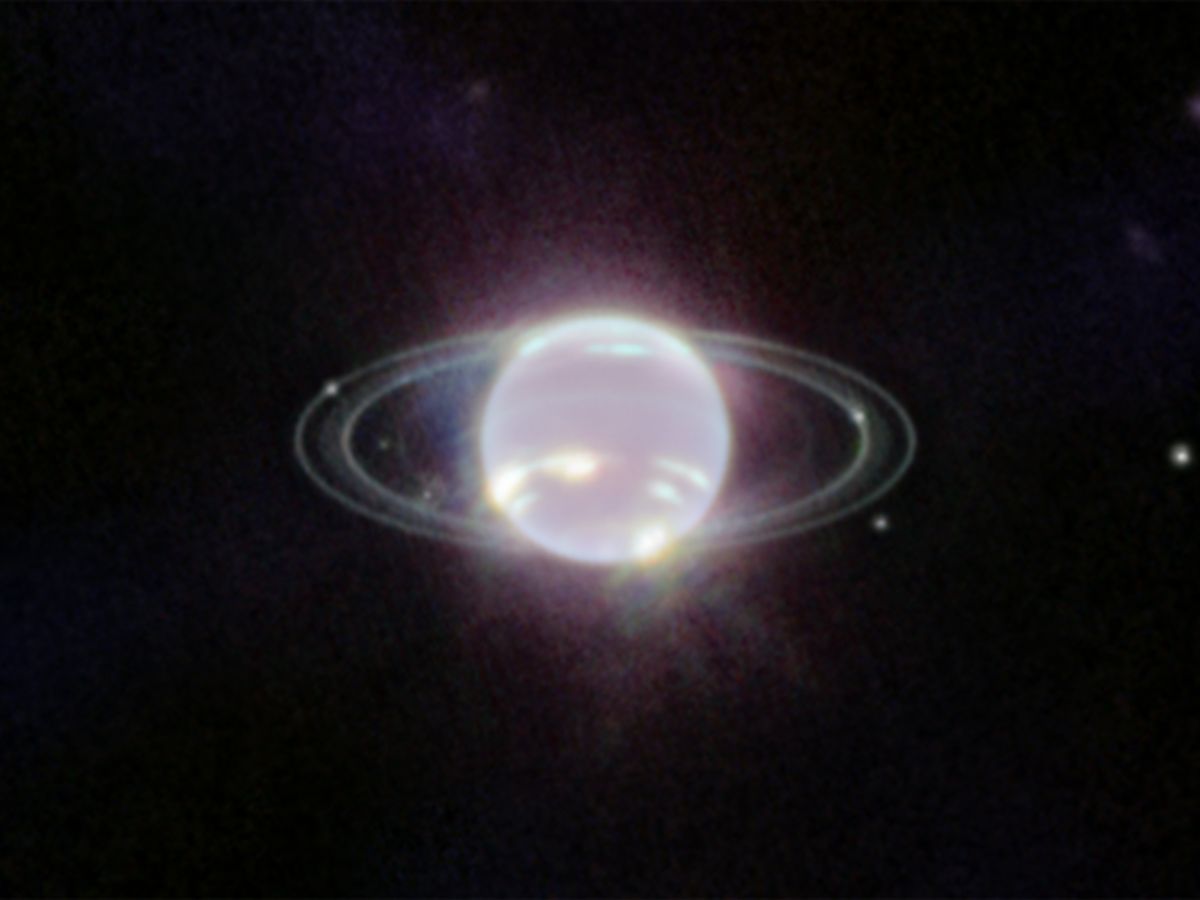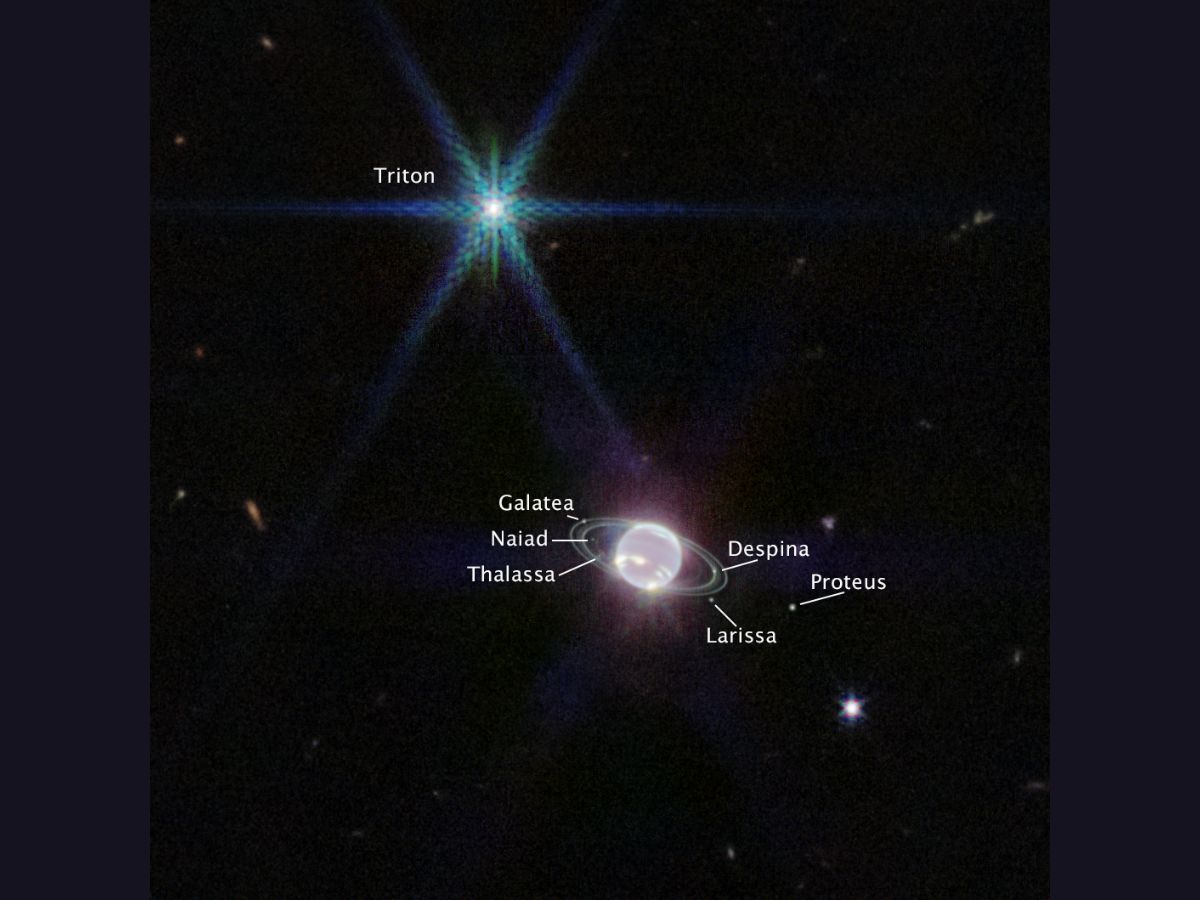[ad_1]
Neptune: NASA’s James Webb Space Telescope never fails to entral the world with its captivating images of the cosmos. The JWST, also called Webb, has captured Neptune, its rings, and seven of its moons. The image gives the ‘clearest’ view of Neptune’s rings in decades, according to NASA.
The crisp view of the ice giant’s rings is breathtaking. The last time Neptune’s rings were detected was in 1989, when NASA’s Voyager 2 spacecraft became the first spacecraft to observe the ice giant during its flyby.
What Webb’s Image Of Neptune Reveals

Neptune’s image, captured by the world’s most powerful telescope, reveals the fainter dust bands around the planet. The proportion of dust in Neptune’s rings is high.
Small amounts of methane can be attributed to Neptune’s signature blue appearance in Hubble Space Telescope images at visible wavelengths.
ALSO READ | James Webb Space Telescope Captures Its First Images Of Mars. Know What They Mean
The ice giant does not appear blue to Webb because the telescope’s Near-Infrared Camera (NIRCam) views objects in the near-infrared range from 0.6 to five microns.
The methane gas in Neptune’s atmosphere strongly absorbs red and infrared light, as a result of which the ice giant is quite dark at near-infrared wavelengths, the exception being the regions with high-altitude clouds.
ALSO READ | James Webb Space Telescope Captures Inner Region Of Orion Nebula. See pics
These methane-ice clouds appear as bright streaks and spots because they reflect sunlight before it is absorbed by methane gas.
Webb has captured Neptune’s rings in amazing detail. A thin line of brightness circles Neptune’s equator. This could be a visual signature of the global atmospheric circulation powering Neptune’s winds and storms.
The atmosphere of Neptune descends and warms at the equator. As a result, the region near the equator glows at infrared wavelengths more than the surrounding, cooler gases.
ALSO READ | Listen In: A New, Immersive Way To Explore NASA James Webb Space Telescope Images, With Sound
The northern pole of Neptune, at the top of the image, is out of view for astronomers, because the ice giant has an orbital period of 164 years. However, the Webb images hint at an intriguing brightness at the northern pole.
For the first time, Webb has revealed a continuous band of high-latitude clouds surrounding Neptune’s southern pole.
Webb Has Captured 7 Of Neptune’s 14 Known Moons
Astronomers have identified 14 moons orbiting Neptune. Of these, Webb has captured seven moons. The moons seen in Webb’s image are Galatea, Thalassa, Proteus, Triton, Naiad, Despina, and Larissa.

A very bright point of light sporting diffraction spikes is seen in Webb’s image. The bright spot is not a star, but Neptune’s large and unusual moon, Triton.
Triton is covered in a frozen sheet of condensed nitrogen. The moon reflects an average of 70 per cent of the sunlight that hits it. In Webb’s image, Triton outshines Neptune because the ice giant’s atmosphere is darkened by methane absorption at these near-infrared wavelengths.
ALSO READ | Astronomer Creates Breathtaking Image Of ‘Phantom Galaxy’ Using Data From James Webb Space Telescope
Astronomers believe that Triton was originally a Kuiper belt object that was gravitationally captured by Neptune because the moon orbits the ice giant in an unusual backward orbit.
Scientists have planned additional Webb studies of both Triton and Neptune in the coming year.
More About Neptune
Neptune was discovered in 1846. The ice giant is located 30 times farther from the Sun than Earth, and orbits in the remote, dark region of the outer solar system. Since Neptune is located at an extreme distance, the Sun appears faint and small from the planet. As a result, high noon on Neptune is similar to a dim twilight on Earth.
Due to the chemical composition of Neptune, the planet is characterized as an ice giant. Neptune is much richer in elements heavier than hydrogen and helium, compared to the gas giants Jupiter and Saturn.
[ad_2]
Source link